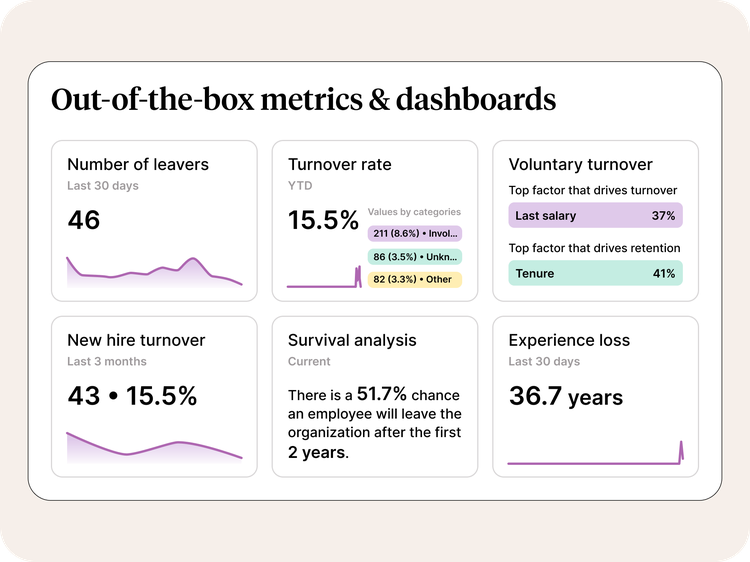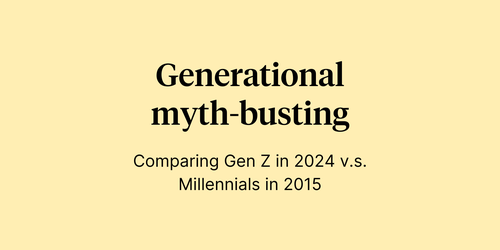
In many ways, employee engagement is like the wind. You feel it. You hear it. You see its impact on the world around you. But you can’t quite wrap your arms around it.
Employee engagement is a hot topic in the HR world, but it remains a nebulous concept for many organizations. This lack of clarity has led to an oversimplification – equating an engaged employee to a “good” employee. That’s not quite accurate.
So, what exactly is employee engagement? And perhaps most importantly, how can you measure employee engagement and develop your own engagement strategy? Let’s explore the answers to both of these questions and more!
Employee engagement: What it really means (and why it matters)
Here’s the employee engagement definition we use here at Culture Amp:
Employee engagement represents the levels of enthusiasm and connection employees have with their organization. It’s a measure of how motivated people are to put in extra effort for their organization and a sign of how committed they are to staying there.
Engaged employees are enthusiastic, committed, and motivated. These are valuable qualities in any organization, which is why many leaders are on a mission to improve employee engagement.
However, engagement isn’t actually something you can act on. It’s an outcome of an organization’s actions and overall employee experience.
Is engagement just about employee satisfaction? Let’s break it down
A common misconception is that employee engagement and employee satisfaction are the same. But they’re not – and understanding the difference is crucial for building a thriving workplace.
Defining job satisfaction vs. employee engagement
First, let’s define each term:
- Employee satisfaction: This refers to how content an employee is with their pay, benefits, and work conditions. Satisfaction is often passive, meaning that while employees may like their jobs, they aren’t necessarily motivated to go above and beyond.
- Employee engagement: Engagement goes beyond satisfaction. Engaged employees are enthusiastic, motivated, and deeply connected to their work, colleagues, and company mission.
Content vs. committed: The key difference
A satisfied employee might show up, go through the motions, and then head home, feeling comfortable but not particularly driven. On the other hand, an engaged employee brings energy, creativity, and effort to their everyday responsibilities, actively contributing to their company’s success.
While job satisfaction is valuable, engagement can fuel heightened performance, drive innovation, and increase employee retention. That’s why it’s critical for businesses to focus on creating an environment that fosters engagement, not just satisfaction. By doing so, they can unlock employee loyalty, boost productivity, and build a thriving workplace culture that attracts and retains top talent.
Tracking engagement is the secret to a thriving workplace
At this point, most people leaders are familiar with the benefits of employee engagement, including greater productivity, higher satisfaction, increased employee retention, and improved company performance.
But what are the benefits of measuring employee engagement? Why go through the work of surveying employees, analyzing the data, and understanding how your organization currently stacks up? Measuring your employee engagement allows you to:
- Identify strategic changes that will improve the experience of your staff, company culture, and the entire organization.
- Foster a culture of trust and boost employee loyalty as you demonstrate to employees that you value their experiences and insights
- Build a strong business case for any employee initiatives you want to implement (like investing in employee development or employee recognition programs), so you can readily show whether or not they improve engagement
As the old saying goes, “You can’t improve what you can’t measure.” If you’ve set your sights on improving employee engagement within your organization, you first need to know where you’re starting – and how you’ll monitor your progress.
The hidden cost of disengagement (and how to fix it)
Disengagement can cost your business big. According to Gallup research, unengaged and actively disengaged employees cost businesses $8.9 trillion in lost productivity. Where do these costs take root?
- Lost profitability: Disengaged employees contribute less than their engaged peers, leading to missed revenue opportunities and lower overall performance.
- Lower productivity: When employees lack motivation, efficiency drops, projects slow down, and innovation stalls.
- Increased absenteeism: Disengaged employees are more likely to miss work, leading to staffing shortages and delayed projects. Persistent absences can even place a strain on engaged team members, who may be asked to take on an absent colleague’s workload to meet pressing deadlines.
The good news? Disengagement can be reversed. By regularly gathering employee feedback and analyzing results to understand what factors are negatively impacting your employees, your organization can make targeted improvements to re-engage employees – before it's too late.
How to spot disengagement before it’s too late
Want to catch disengagement before it takes hold in your organization? Keep an eye out for these warning signs:
- Decreased productivity: Disengaged employees often do the bare minimum to get by. They are more likely to embrace “quiet quitting” and may seem withdrawn in meetings, stop volunteering for projects, or avoid contributing ideas.
- Toxic negativity: Nobody likes a Debbie Downer. Disengaged employees are more likely to have a negative attitude and express their dissatisfaction, which can spread to colleagues and disrupt team morale and dynamics.
- Increased absenteeism: A disengaged employee may struggle to find motivation to show up, leading to more frequent absences or a noticeable dip in reliability.
- Increased turnover: Over time, disengaged employees may even decide to pursue employment elsewhere.
Disengagement is often a sign of deeper issues within your organization, like unclear goals, limited autonomy, or poor cross-functional relationships. As a business, it’s essential to listen to your employees, understand the root causes of any disengagement, and take meaningful action to enhance their overall experience.
By addressing these concerns, you may be able to transform disengaged employees into motivated, enthusiastic contributors before it's too late!
How to measure employee engagement: A step-by-step guide
Determining how to measure employee engagement can be notoriously tough for organizations, but finding the right approach will benefit your organization.
This is because engagement encompasses so much. Every aspect of an employee’s experience with your organization – their leadership, recognition, development opportunities, relationships with colleagues, and more – has a distinct impact on their level of engagement.
That means measuring employee engagement feels a lot like measuring every aspect of your organization. It can seem overwhelming, which means many companies default to gut feelings and simplistic assumptions (“Well, everybody seems happy.”).
Let’s look at how to go beyond hunches and get a real, research-backed grasp on how engaged your employees are. That way, you can take a data-driven approach to crafting your employee engagement strategy.
Step 1: Choosing the right way to measure engagement (Hint: It’s not one-size-fits-all)
In terms of the actual quantifiable measurement methods, there are numerous ways that you can take the temperature of your staff’s engagement.
Employee engagement surveys and eNPS
Conducting employee engagement surveys – both baseline surveys and pulse surveys – is the most popular and reliable method for measuring engagement. However, complementing them with other measurement methods will give you a more holistic picture of what’s really happening within your organization. One common method is measuring employee Net Promoter Score (eNPS). This key metric measures employee sentiment and tracks changes over time by asking employees how likely they are to recommend your company as a great place to work.
Interested in launching your own employee engagement surveys? Learn how Culture Amp Engagement can help your business understand what motivates and inspires your employees.
Other key organizational metrics
In addition to engagement surveys, your business can also monitor and track changes in other key organizational metrics, such as:
- Performance: Track quality of work, goal attainment, and performance ratings to understand the state of employee performance.
- Productivity: Analyzing output levels, efficiency, and project completion rates can help your business keep tabs on employee productivity.
- Retention: A sudden spike in departures or a decline in tenure may signal deeper issues affecting employee satisfaction and commitment.
- Absenteeism rates: High levels of unplanned absences can indicate disengagement.
- Internal mobility rates: Tracking promotions and lateral moves – especially among minority groups – can help you better understand career growth opportunities within your organization.
- Survey participation rates: Low survey response rates could be a signal of employee disengagement.
Culture Amp People Analytics transforms your people data into a strategic advantage with interactive dashboards that go beyond visuals – they help you tell a compelling story. Uncover opportunities for meaningful action and deliver tailored engagement insights to key decision-makers with the context they care about.

Step 2: The art of asking the right questions (without survey fatigue)
Considering that engagement surveys will likely be a big piece of the puzzle as you figure out how to measure employee engagement, let’s talk more about that specific method.
To establish a baseline, start with a comprehensive employee engagement survey. Keep the survey to about 50-60 questions so that it only takes people about 10 minutes to complete.
However, simply rolling out this engagement survey isn’t enough – to dig deep into the outcomes and drivers of employee engagement, you need to ask the right questions.
The 5 must-have engagement survey questions
At Culture Amp, we use five survey questions to measure the outcomes of employee engagement. We call this our “engagement index.” Employees are asked to rate their agreement with the following outcomes and statements:
- Pride: “I am proud to work for [Company].”
- Recommendation: “I would recommend [Company] as a great place to work.”
- Present commitment: “I rarely think about looking for a job at another company.”
- Future commitment: “I see myself still working at [Company] in two years’ time.”
- Motivation: “[Company] motivates me to go beyond what I would in a similar role elsewhere.”
These five questions are a solid starting point, but a thorough engagement survey goes even further, asking targeted questions relating to the four main factors that drive employee engagement: leadership, enablement, alignment, and development. An easy way to remember them is the acronym LEAD.
These questions ask employees to rate their agreement with statements like:
- “The leaders at [Company] keep people informed about what is happening.”
- “I have access to the things I need to do my job well.”
- “I receive appropriate recognition when I do good work.”
- “I believe there are good career opportunities for me at this company.”
…and plenty more. Asking about the above outcomes and drivers (we have an employee engagement survey template to get you started) will help you craft a survey that collects data on all the aspects of engagement – rather than getting hung up on one focus area and missing something important as a result.
Open-ended vs. scaled questions – what works best?
There are two types of questions you can ask in an employee engagement survey: scaled questions and open-ended questions. Here’s a closer look at both:
-
Scaled questions ask respondents to use the Likert Scale to gauge employee sentiment, ranging from favorable to neutral to unfavorable. This question type translates complex factors into measurable data, helping to provide a clear, trackable view of engagement trends so you can assess progress over time.
- Example: I feel like I belong at [Company].
- Available Responses: Strongly Disagree, Disagree, Neither Agree nor Disagree, Agree, Strongly Agree
-
Open-ended questions, on the other hand, offer deeper insights by uncovering the "why" behind the numbers. They help identify root causes, giving you the context needed to understand what’s working within your company and what needs improvement.
- Example: What actions could your manager take to strengthen your sense of belonging at our company?
Incorporating both question types in your surveys allows your organization to quantify engagement, track trends, and pinpoint improvement areas while gathering the qualitative insights necessary for developing an effective action plan.
Just note that open-ended questions are only effective if employees believe their feedback will be heard and acted upon. Your employees must feel their voices drive real change to truly benefit from these insights.
Step 3: Turning data into meaningful conversations
When you have your engagement survey results, it’s time to review and make sense of the employee feedback you’ve gathered. Our people scientists can help you interpret your data and develop relevant action plans. Or, if you want to dive into the results yourself, be prepared to dig deeper into unexpected or unclear findings.
Spotting trends and hidden insights in survey responses
If you feel surprised or curious about your survey results, dig deeper. Filtering results by factors like office location, department, tenure, gender, or race can reveal disparities that may only affect certain groups, helping you uncover trends that might otherwise go unnoticed.
Gathering qualitative insights from employees and managers
Once you identify an interesting pattern in your data, gathering additional context can help you make more informed decisions. Here are a few ways to gain deeper insights:
- Focus groups: Assemble groups of employees and host open discussions to explore recurring themes and issues’ root causes.
- Targeted interviews: After your focus group conversations, follow up with specific employees to hear firsthand perspectives on their experiences and concerns.
- Exit interviews and stay interviews: These conversations can also help uncover key factors influencing engagement and retention.
Data is undeniably helpful. But supplementing the numbers with face-to-face conversations and experiences adds color, context, and details.
Step 4: Creating action plans that actually drive change
You’ve reached the most crucial step in this guide: turning insights into action. Once you have your quantitative survey data and qualitative data from employee conversations, you’re ready to take timely action to improve your employee experience.
Every organization’s action plan will be unique and tailored to its specific survey results. Your plan might include initiatives like expanding professional development opportunities, creating employee recognition programs, offering leadership training, or enhancing work-life balance.
Taking action isn’t just about making improvements; it’s also about trust. When employees see leadership responding to their feedback, it shows them that their voices matter. This, in turn, encourages more honest input in future surveys, creating a continuous cycle of engagement and improvement.
Need help crafting an effective action plan? Check out our guide on Creating a post-survey action plan, which offers templates and exercises for turning insights into impactful change.
Step 5: Engagement isn’t a one-and-done deal – here’s how to keep improving
After taking action, ensure you’re set up to monitor your progress moving forward. Pulse surveys are short surveys (typically 10-20 questions) that track progress on a specific focus area of your choice.
Setting up an engagement check-in cadence that works
Wondering when and how often to use different surveys to measure and monitor employee engagement? Here at Culture Amp, we recommend the following survey cadence using a one-year structure with one survey per quarter:
- Quarter one: Baseline survey that provides the broad baseline for your culture or engagement levels
- Quarter two: Pulse survey that tracks progress on a specific activity resulting from your baseline survey, as well as core engagement questions
- Quarter three: Deep-dive survey that helps you identify and diagnose a specific topic that’s too difficult or complex to dig into in a baseline survey
- Quarter four: Pulse survey that tracks progress on a specific activity, as well as core engagement questions and follow-up questions based on results from your deep-dive survey
You don’t have to follow this structure exactly, but it’s a solid framework for soliciting employee feedback without making your workforce feel like you’re asking the same questions over and over.
In short, employee engagement isn’t something you measure once. Much like your organization itself, your engagement levels are ever-changing. Monitor them regularly and reliably to stay on top of those inevitable ebbs and flows.
Tracking engagement is just the beginning – here’s what’s next
Employee engagement can feel difficult to define – and even harder to measure. But rest assured: The five steps outlined above will guide you through the process of measuring employee engagement. You can assess your employees’ enthusiasm, commitment, and motivation using these reliable methods. Use this information to build an effective employee engagement strategy that drives meaningful improvements in your company culture and employee experience.
While some organizations are quick to point to “survey fatigue” as an argument against closely monitoring engagement levels, it’s worth remembering: People don’t get tired of offering their opinions – they get tired of their employers failing to act on them. Employee engagement data is valuable, and when you act on what you learn from it, you show your employees that they’re valuable to you.




